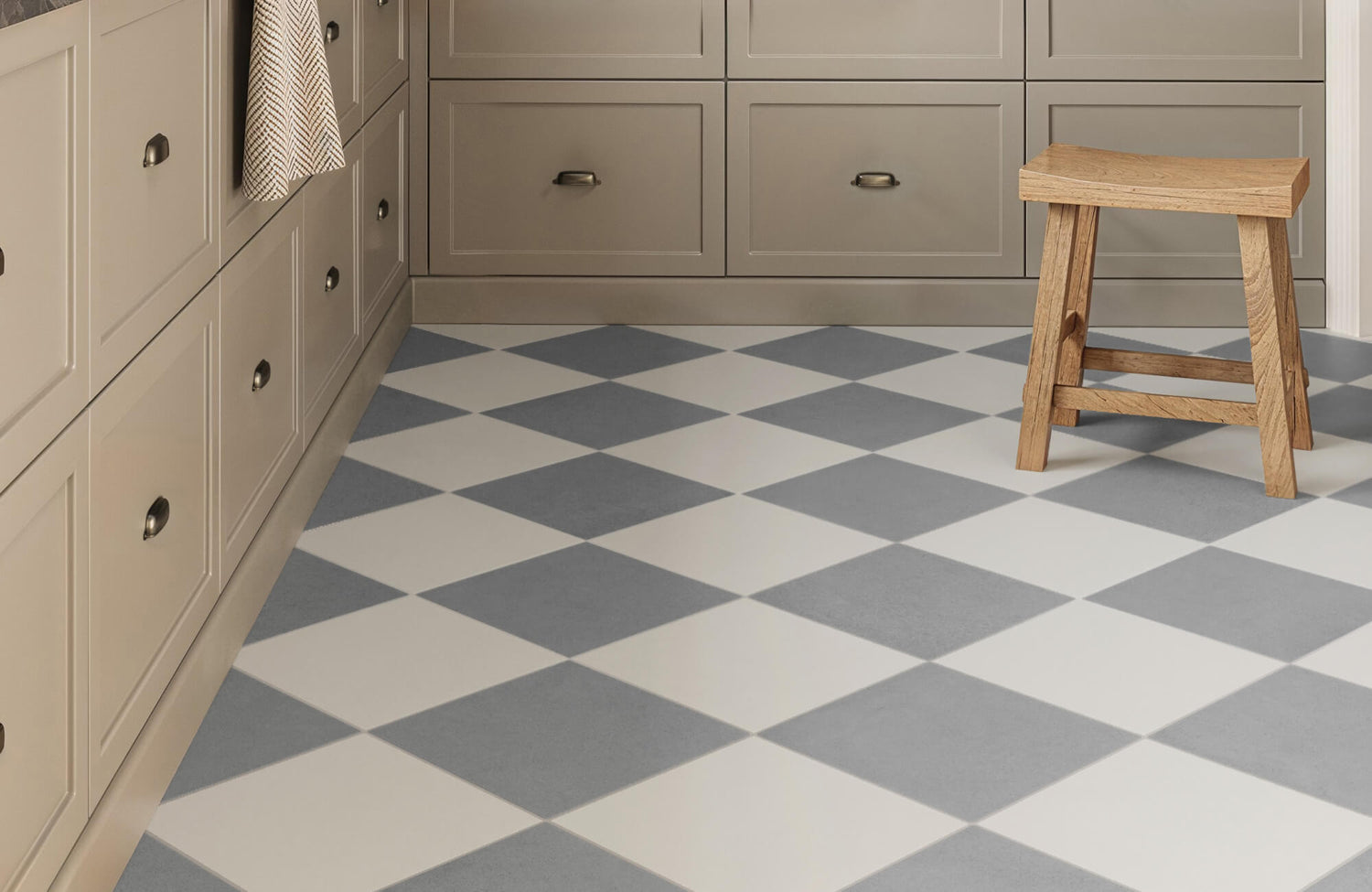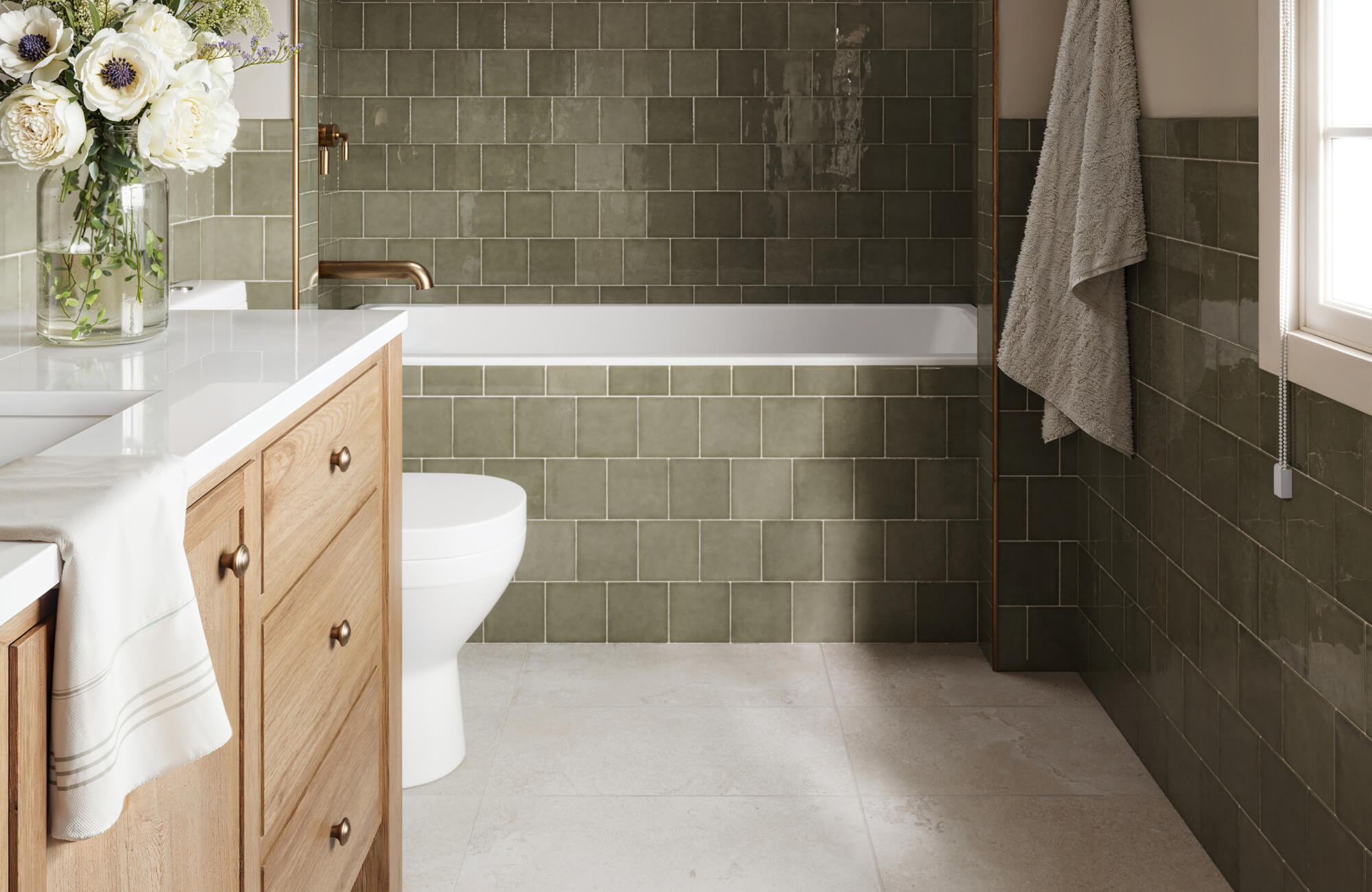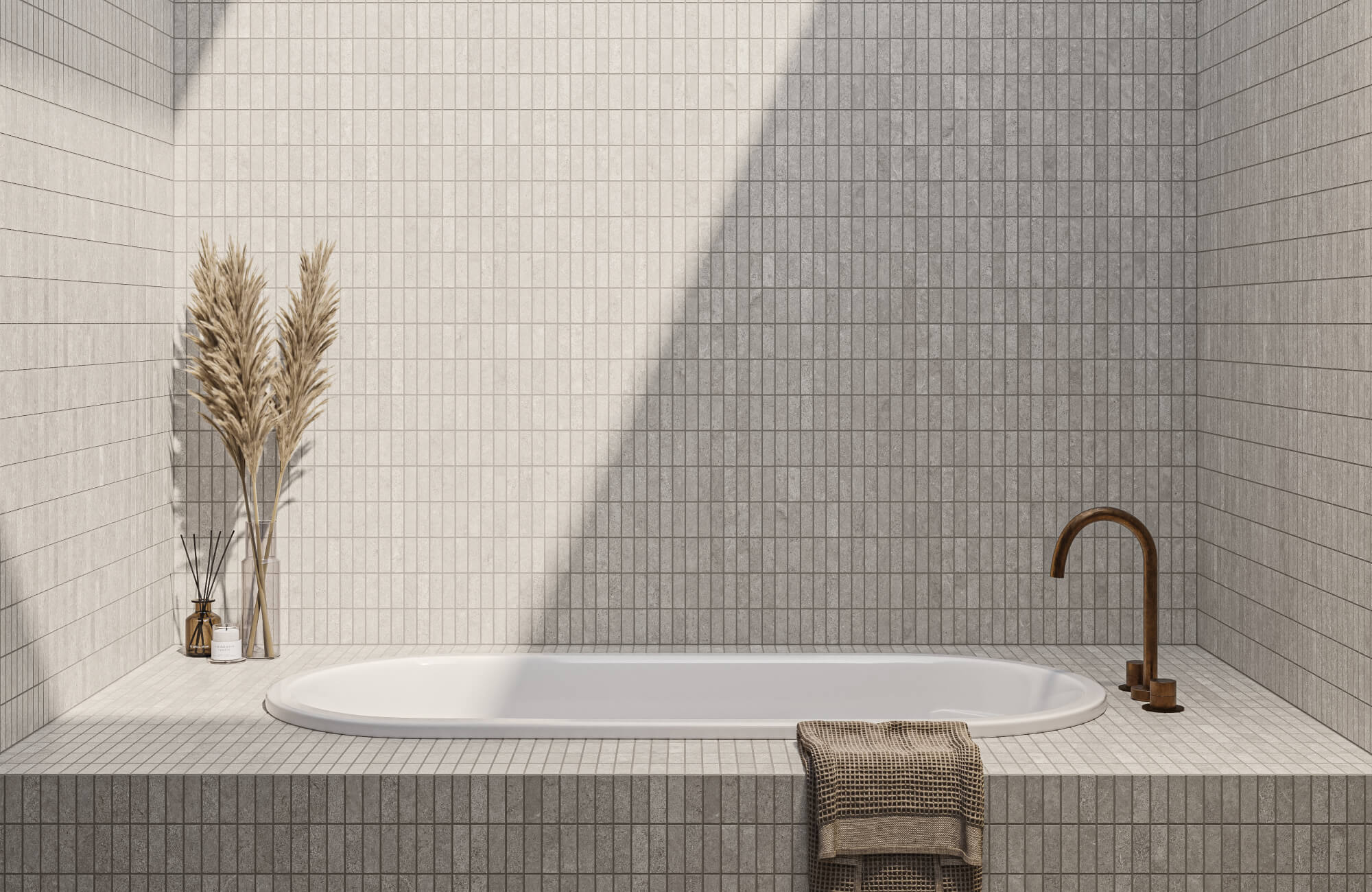Checkered floors are a timeless design choice that can add vintage charm or modern sophistication to any space. Whether featured in kitchens, bathrooms, or entryways, this bold pattern creates visual impact while remaining adaptable to various styles.
Beyond aesthetics, selecting the right tile is essential for durability and maintenance. Factors like material strength, moisture resistance, and long-term upkeep determine which tiles work best in different environments. This article explores the top tile options for checkered floors, helping you achieve a stylish and lasting design.
Durability and Practicality for Busy Areas
Checkered floors, especially in busy zones like kitchens and hallways, require robust materials that can withstand daily wear and tear.
Porcelain Checkered Tile
Porcelain checkered tile is a popular choice due to its exceptional strength and resistance to scratches, stains, and moisture. Its density, achieved through a higher firing temperature and finer clay composition, makes it ideal for busy areas, ensuring longevity and easy maintenance. Selecting the appropriate Porcelain Enamel Institute (PEI) rating is crucial, with a PEI rating of 3 or higher recommended for residential floors. Higher ratings indicate greater abrasion resistance, making them perfect for areas with heavy use.
Consider using through-body porcelain tiles, where the color extends throughout the tile, minimizing the visibility of chips and ensuring a long-lasting appearance. Many reputable manufacturers offer high-quality porcelain tiles with extended warranties, providing homeowners and designers peace of mind when investing in durability. For a stylish and practical option, the Leona 12x12 Checkerboard Matte Porcelain Tile in Calacatta and Amani Grey delivers a sophisticated take on the classic checkered pattern while offering the resilience needed for busy areas.
Ceramic Checkered Tile
Ceramic checkered tile offers a more budget-friendly alternative to porcelain while still providing good durability. Though not as dense as porcelain, making it slightly more susceptible to scratches and chips, ceramic tile remains a solid option for residential applications, particularly in areas with moderate use like walls and backsplashes.
Understanding the different grades of ceramic tile is also essential when selecting materials for a checkered floor. Grade 1 tiles are the highest quality with minimal imperfections, while lower grades may have minor cosmetic flaws. Grade 1 or 2 ceramic tiles are recommended to achieve a consistent look and ensure longevity. Rectified ceramic tiles, which are precisely cut and calibrated, allow for thinner grout lines, creating a seamless checkered pattern that enhances the room’s overall aesthetic.
Natural Stone
Certain natural stones, like granite and marble, offer a luxurious look while maintaining impressive durability. However, they require more maintenance than porcelain or ceramic due to their inherent porosity. Granite is one of the hardest natural stones, making it highly resistant to scratches and stains, while marble, though visually stunning, is softer and more prone to etching and staining.
Regular sealing is also crucial to protect natural stone from moisture and stains, with the frequency of sealing depending on the stone's porosity. Marble, for instance, requires more frequent sealing than granite. A honed or leathered finish is recommended for busy areas, as these surfaces show fewer scratches and signs of wear compared to polished finishes.

Style and Design Considerations
Beyond durability, the aesthetic appeal of a checkered floor is paramount. Tile material, size, and layout influence the overall look of a checkered floor, shaping its style and visual impact.
Timeless Elegance with Classic Black and White
The black-and-white checkered pattern has long been a symbol of vintage charm, often gracing traditional kitchens, bathrooms, and entryways. To capture this timeless aesthetic, the choice of tile size and layout plays a crucial role. Smaller tiles, like 12x12 inches or even more compact formats, evoke an authentic retro vibe, reminiscent of old-world design. On the other hand, larger tiles create a more modern, expansive look, offering a cleaner, less busy appearance. For those seeking a refined take on this classic style, the Leona 12x12 Checkerboard Polished Porcelain Tile in Calcatta and Nero Marquina, a marble look option shown in the photo above, adds a luxurious, sophisticated touch that effortlessly bridges traditional and contemporary interiors.
To further enhance the checkered design, beveled edges can create crisp, defined lines between the black and white tiles, adding an extra layer of visual interest. Pairing the tiles with contrasting grout colors can also deepen the pattern’s impact, bringing more dimension and texture to the space. Whether you’re embracing a nostalgic feel or updating a classic look with a modern twist, the black and white checkered floor remains a stylish and enduring choice that never goes out of fashion.
Modern Designs with Color and Texture Variations
Checkered floors can also be adapted to modern aesthetics by incorporating different colors and textures. Gray and white combinations, like the Palmer 12x12 Checkerboard Matte Porcelain Tile in White and Grey, create a contemporary feel, while tiles that mimic wood or stone add depth and character. These variations help checkered floors blend seamlessly into modern interiors, whether minimalist, industrial, or transitional in style.
Larger checkered tiles, like 24x24 inches or more, lend a seamless, expansive feel to a room, making them perfect for spacious areas or open-concept layouts. For a modern twist on this classic design, arranging the tiles in a diagonal pattern adds a dynamic visual element that brings fresh energy to the space while still honoring the timeless appeal of the checkered look. To further enhance the design, opting for a contrasting grout color can sharpen the definition of each tile, turning the floor into a striking focal point that draws the eye.
Elevating Designs with Borders and Inlays
Adding borders and inlays enhances the sophistication of a checkered floor, transforming it into a statement feature. Borders can be achieved with contrasting colors, different tile materials, or thin strips of metal for a sleek, contemporary touch. These elements help define the space and create a refined, structured appearance.
Inlays, such as geometric shapes or intricate floral designs, introduce an artistic element that personalizes the space. Advanced waterjet technology also allows for precise inlay designs using different tile materials, ensuring a high-end, custom look. When incorporating borders and inlays, selecting a color scheme that complements the overall design ensures a cohesive and balanced aesthetic.
Tile Finishes and Their Impact on Checkered Floors
The finish of a tile plays a crucial role in both the appearance and functionality of a checkered floor. While the black-and-white pattern itself creates a striking visual impact, the right finish can enhance light reflection, improve durability, and influence maintenance requirements. The choice between polished, matte, or textured finishes depends on factors such as the room’s lighting, level of use, and overall design aesthetic.
A polished finish adds a sleek, shiny appearance that enhances brightness by reflecting natural and artificial light. This makes it a great choice for smaller spaces, as it can make a room feel more open and airy. However, polished tiles can become slippery when wet, which makes them less ideal for areas like bathrooms or entryways that experience frequent moisture. They also tend to show smudges and footprints more easily, requiring regular cleaning to maintain their pristine look.
A matte finish offers a more understated, elegant appeal while reducing glare and minimizing the appearance of dust, streaks, or water spots. This makes it a practical choice for busy areas such as kitchens and hallways, where ease of maintenance is a priority. Matte tiles also provide better traction than polished tiles, making them safer in moisture-prone environments. Their soft, velvety texture enhances the timeless feel of checkered floors without overpowering other design elements.
Textured finishes, including honed and brushed surfaces, introduce a tactile quality that enhances slip resistance and durability. These finishes are particularly beneficial for natural stone tiles, as they help conceal minor imperfections and wear over time. Textured tiles can also add depth and dimension to a checkered floor, creating subtle variations in light reflection that enhance the overall aesthetic. However, they may require more effort to clean, as dirt and grime can settle into their uneven surfaces.
Choosing the right finish can significantly impact both the look and functionality of your checkered floors, but it can be challenging to visualize how different options will work in your space. To simplify the decision-making process, our advanced augmented reality (AR) technology lets you preview a variety of tile finishes in real time. Whether you're drawn to the glossy elegance of polished tiles, the understated charm of matte surfaces, or the rugged appeal of textured finishes, the AR tool helps you see exactly how each option interacts with your room's lighting and design. This ensures you’ll find the perfect combination of style and practicality for your home.

Cost Comparison and Budgeting
The cost of materials and installation plays a significant role in choosing the right tile. The cost of tiles and installation varies based on material, design complexity, and labor rates.
Understanding Material Costs for Different Budgets
Tile prices vary widely, from budget-friendly options to high-end selections. Ceramic tile is the most affordable, typically costing $1 to $5 per square foot, while luxury vinyl tile (LVT) offers a cost-effective alternative at $2 to $7 per square foot. Natural stone, such as marble and high-end granite, sits at the top of the price range due to its luxurious appeal and maintenance needs, ranging from $10 to $30 per square foot.
For those seeking a balance between affordability, durability, and style, porcelain remains a practical choice. With prices typically ranging from $3 to $10 per square foot, it offers impressive resilience, moisture resistance, and long-term performance, making it a worthwhile investment for both residential and commercial spaces. Factoring in trim pieces, grout, and sealants also helps ensure a comprehensive budget that covers all aspects of installation.
Key Factors That Influence Installation Costs
Installation costs vary depending on the complexity of the pattern, space size, and regional labor rates. Intricate layouts, such as diagonal checkered patterns or those with inlays, require more time and expertise, increasing labor costs.
The size of the space greatly influences the overall cost, as larger areas require more materials and longer installation times. Additionally, regional location can impact pricing, with tile installation rates varying depending on local demand and the availability of skilled labor. To achieve the best results, it’s important to hire an experienced installer who is familiar with the intricacies of checkered tile patterns, ensuring a precise and professional finish.

Maintenance and Cleaning
Proper maintenance is essential to preserve the appearance and longevity of a checkered floor. The best cleaning methods vary depending on the tile material, so always consult the tile manufacturer’s recommendations before using any cleaning products or techniques. This ensures compatibility with the tile’s surface and prevents accidental damage that could compromise its durability or aesthetic.
Daily and Weekly Cleaning Routines
For porcelain and ceramic checkered floors, daily sweeping or vacuuming is essential to remove dust, dirt, and debris that can dull the surface over time. A damp mop with a pH-neutral cleaner once a week helps maintain the tile’s shine while preventing grime buildup. Porcelain and ceramic are also highly resistant to stains and moisture, making them relatively low maintenance, but it's best to avoid abrasive cleaning tools or harsh chemicals that can damage the finish.
Natural stone checkered floors, like marble or travertine, require more delicate care to maintain their natural beauty. Cleaning with a microfiber mop and a stone-safe cleaner is recommended to preserve the stone's texture and prevent surface damage. Harsh, acidic cleaners such as vinegar or citrus-based products, should be avoided, as they can cause etching and discoloration. To further protect the stone, periodic sealing is essential, as it helps prevent moisture absorption.
Preventing and Removing Stains
Promptly cleaning spills is crucial in preventing stains, especially on more porous materials like natural stone. Liquids such as wine, coffee, and oil can seep into unsealed stone tiles, leading to permanent discoloration if not addressed immediately. Using a dry, absorbent cloth to blot spills, rather than wiping them, helps prevent the stain from spreading.
For porcelain and ceramic tiles, mild bleach solutions or diluted hydrogen peroxide can effectively lift stains without causing damage. However, natural stone requires specialized pH-balanced stone cleaners to remove stains safely. Regularly resealing stone tiles also provides an additional layer of protection against staining, making it easier to clean spills before they penetrate the surface.
In addition to protecting the tiles themselves, sealing grout lines annually is essential for preserving the look and longevity of checkered floors. Because grout is highly porous, it can absorb moisture over time, leading to discoloration, mold growth, and potential weakening. Applying a high-quality grout sealer helps repel liquids and prevent dirt buildup, keeping the checkered pattern sharp and well-maintained for years.
Why Porcelain Is the Best Tile for Checkered Floors
Choosing the right tile for a checkered floor means considering durability, style, budget, and maintenance. Ceramic provides an affordable option, while natural stone offers a distinctive, high-end appeal. For those looking for a balance of strength, moisture resistance, and ease of maintenance, porcelain remains a standout choice. Its durability makes it well-suited for busy spaces, while its versatility allows it to replicate the luxurious look of natural stone with lower upkeep.
Whether opting for a classic black-and-white pattern or a contemporary twist with bold colors and textures, porcelain tiles offer the perfect combination of elegance and practicality. If you're unsure which option best suits your space, contact us for expert guidance. With careful selection and proper installation, a porcelain checkered floor can provide both visual appeal and long-term durability, making it a timeless and functional choice for any interior!









